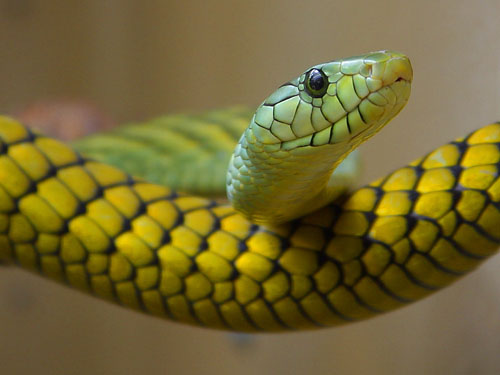lighting, distance, safety Don't approach too closely any snake that is venomous or any that cannot be identified with certainty. It is essential to know quite a bit about snakes before pursuing or approaching them. They are masters of disguise using camouflage evolved over millions of years, so it is all too easy to get bitten by a snake that was not even seen until it was too late.

Snakes can move very fast. They can not only strike with lightning speed over a range equal to half their body length, but also move across the ground surprisingly rapidly. Keep at a minimum safe distance of at least the body length of the snake unless you know exactly what you are doing, and certainly do not touch any snake unless you are knowledgeable about the particular species and understand how to handle it safely.
When hunting for snakes, be sure to wear suitably heavy clothing and boots or leg gaiters for protection. Advise other people of your intentions, work in conjunction with someone else, and carry a mobile phone programmed with the number for an appropriate emergency medical centre. If pursuing dangerous snakes, carry anti-venom serum if at all possible. Such treatments are usually effective only when administered within a narrow window of opportunity.
Snakes blend in well with their environment and consequently may not be easy to find. They live in trees, vegetation, under wood and rocks, and in many other locations where they may see you before you spot them. Having found a snake that you wish to photograph, try not to disturb it unnecessarily. remain quiet and patient and observe its movements. Eventually it may emerge in to the open or move to a position where it can be photographed without any disturbance.
It may seem obvious to use a telephoto lens to avoid a close approach to the subject, but this technique does not necessarily produce good images. One problem is that a longer distance between camera and subject is more likely to be obstructed by leaves, branches etc. Using a shorter lens, such as a Nikkor 105mm Micro, requires the photographer to approach more closely but makes it easier to obtain a clear view and a wide range of viewpoints.
As with human portraiture, a closer approach produces more intimate images. However, working in this manner requires that the photographer becomes more involved with the subject. Remain alert at all times to the behaviour of the snake. A specimen that is flicking its tongue is supremely alert and may feel aggravated or threatened. It is updating chemosensory information so as to be prepared for any form of danger. Try to keep something between the snake and the photographer. Some people use a screen or umbrella equipped with a small hole for the lens of the camera. It a snake strikes, the screen takes the first hit.
Close-up images of the head of a snake, perhaps with the body in soft focus in the background, are generally more interesting than images showing the reptile sliding through confusing undergrowth. Try to find a clear background or at least an angle of view that allows a distant backdrop of vegetation to be rendered well out of focus. A background of a different colour to the snake makes the subject stand out in an image.






